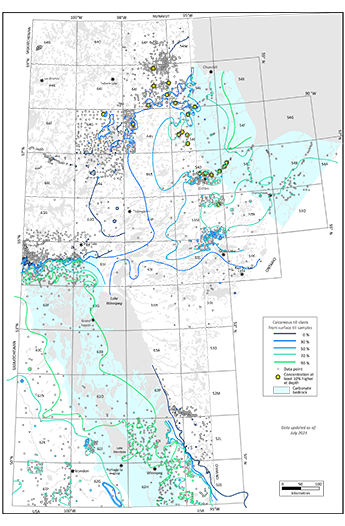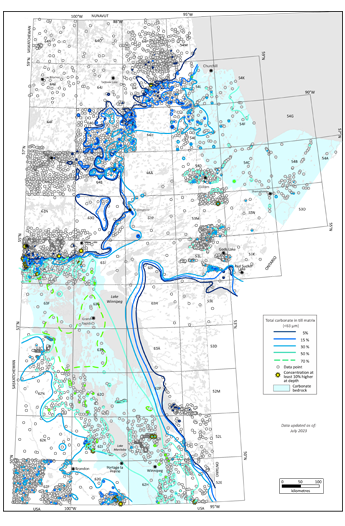Geoscience
Manitoba carbonate dispersal analyses in till
In northern Manitoba, Paleozoic calcareous clasts were glacially dispersed westwards for distances up to 380 km beyond the limit of carbonate bedrock, within subglacial environments of reduced ice-bed coupling and fast ice flow. The dispersal pattern in the surface till reflects the interaction of Keewatin and Hudson-Labrador ice in the region during multiple glaciations. The Ca-rich till is not homogeneous, but exhibits spatially-variable dilution by entrainment of local to regionally sourced granitoid and greenstone belt clasts and recycled (inherited) low concentrations of other farther-travelled clasts (exotic Precambrian shield clasts and Dubawnt Supergroup erratics).
The data suggest that carbonate dispersal occurred prior to deglaciation, and that the maximum westward extent of Ca-rich tills has been subject to spatio-temporal overprinting (re-working) by Keewatin ice of northern and/or northeastern provenance.
Ongoing hand-contoured data analysis
README
GeoFile 7: Manitoba till-matrix geochemistry compilation: total carbonate of the silt plus clay (<63 µm) size-fraction
Till-matrix clast metadata, Manitoba (Microsoft® Excel® file)
Calcareous pebbles in till matrix (<63 µm, mixed ct. % and wt. %) Click image to enlarge |
Till-sample locations where the silt plus clay (<63 μm) size-fraction of the matrix was analyzed for total carbonate (CO3) in Manitoba Click image to enlarge |
Relevant Manitoba literature
- Gauthier, M.S., Hodder, T.J., Ross, M., Kelley, S.E., Rochester, A. and McCausland, P. 2019: The subglacial mosaic of the Laurentide Ice Sheet; a study of the interior region of southwestern Hudson Bay; Quaternary Science Reviews, v. 214, p. 1–27, https://doi.org/10.1016/j.quascirev.2019.04.015.
- Distribution and type of sticky spots at the centre of a deglacial streamlined lobe in northeastern Manitoba, Canada (2014; doi:10.1111/bor.12064) (http://onlinelibrary.wiley.com/doi/10.1111/bor.12064/abstract)
- Drift carbonate on the Canadian Shield. II: Carbonate dispersal and ice-flow patterns in northern Manitoba. (1988; doi:10.1139/e88-073) (http://www.nrcresearchpress.com/doi/abs/10.1139/e88-073#.UwYsg3j4Dcs)
- Till geochemistry in west-central Manitoba: interpretation of provenance and mineralization based on glacial history and multivariate data analysis (accepted, Economic Geology)
- Till Composition and Implications for Drift Exploration, Knee Lake-Oxford House Area
M.S. Gauthier (née Trommelen) (Manitoba Geological Survey)
Presented at the Manitoba Mining and Minerals Convention 2013
Watch Presentation
- Surficial geology and glacial history, Lynn Lake - Leaf Rapids area, Manitoba (2008; doi:10.4095/225935) (http://geoscan.nrcan.gc.ca/starweb/geoscan/servlet.starweb?path=geoscan/downloade.web&search1=R=225935)
A note on data reliability:
This compilation is based on different types of geochemical analyses, incorporating data presented at various scales. The data points are hand-contoured, to provide a general picture of the dispersal pattern, and the contour patterns are likely incorrect where only a few data points exist.




